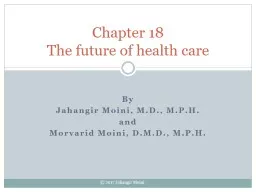

and Morvarid Moini DMD MPH Chapter 18 The future of health care Overview Needs for health care services will increase greatly Mostly due to the increasing elderly population Increases ID: 785095
Download The PPT/PDF document "By Jahangir Moini , M.D., M.P.H." is the property of its rightful owner. Permission is granted to download and print the materials on this web site for personal, non-commercial use only, and to display it on your personal computer provided you do not modify the materials and that you retain all copyright notices contained in the materials. By downloading content from our website, you accept the terms of this agreement.
Slide1
ByJahangir Moini, M.D., M.P.H.andMorvarid Moini, D.M.D., M.P.H.
Chapter 18
The future of health care
Slide2OverviewNeeds for health care services will increase greatlyMostly due to the increasing elderly populationIncreases: Job opportunities Changes in care qualityCosts LegislationPatients must become more involved in their own health care
Slide3Essentials of reformCooperation between providers, insurers, governmentMany Americans get health insurance from employersBut many smaller employers do not offer itDue to premium costs, many people simply go without health insuranceCost of care can reach an insurer’s lifetime limit, due to serious illnesses or accidents
Insured often dropped by the insurer as a result
Slide4Clinical advancementsTechnology must increaseNew health care professionals continually neededBetween 1/3 and 2/3 of future personnel will focus on the elderlyTraining must be expandedFunding needed to support study, research into needs of the elderly
Slide5Clinical advancementsBeginning with future physicians, all medical students should receive geriatric medicine trainingOlder patients often need multiple medicationsOverall declining health, mental capacity influences medicine regimens
Slide6Clinical advancementsTechnologies being developed for regular use:Growing of organs from stem cellsArtificial organs (pancreas and kidney)Tumor testingImmune therapies for cancerCellular phone applications for better healthOdor-sensing devices to diagnose cancer
Saliva testing to determine presence of cancer
Slide7Clinical advancementsTumor samples tested for:280+ genetic mutations that may control tumor growthArtificial pancreas Automated insulin delivery system, predicts glucose levelsImplantable
artificial kidney
Powered by patient’s blood pressure
Uses
silicon nanotechnology
to filter the blood
Slide8Clinical advancementsOdoreader Analyzes odors to detect prostate cancer May be more accurate than testing prostate-specific antigen (PSA) levelsAlso useful in diagnosing bladder cancer and hematuria
Slide9Clinical advancementsNew saliva testIdentify biomarkers of lung cancer“Liquid biopsy” detects: Circulating tumor DNA Mutations in cancer-linked gene –Epidermal growth factor receptor
Slide10Increasing ambulatory, outpatient, and home careRapidly growing area of health careMany medical, surgical procedures performed in ambulatory and outpatient settingsDue to refusal of many insurers to reimburse after hospitalization, this change in location has occurred
Slide11Services now offered in ambulatory and outpatient facilitiesCancer treatmentDiagnostic imagingKidney dialysisRehabilitative servicesUrgent careSports medicine
Certain surgeries
Wellness and preventive medicine services
Slide12Predictions for long-term care65+ population increasing quicklyAffecting need for long-term careDramatic methods of cost control are neededOthers needing long-term care include:Chronically ill Mentally illPermanently disabled
Impaired children
Slide13Long-term care facilitiesNursing homes (70%)Chronic disease hospitalsPsychiatric and mental illness hospitalsRehabilitation hospitalsAssisting living facilitiesShelter homesWorkshopsHome health servicesHospice
Slide14Need for long-term careElderly U.S. population may triple by 2050Costs could be about 10x higher than nowNew areas required:Residential and living facilitiesInstitutions, rehabilitation facilitiesCase managementSelf-care programs
Cost-sharing programs
Slide15Long-term care statistics
Statistic
Comments
Most popular forms
Home health agencies, then nursing
homes, hospices, residential care communities, adult day service centers
Who uses long-term care
About 63% are aged 65
and older
How much of 65+
population are below poverty level
14.8%
What are percentages
of long-term care types of service
66% of disabled elderly are cared for by their families; 26% by family members along with paid help; 9% from only paid help
Slide16Increasing populations25% of U.S. made up by racial and ethnic minority groupsFacilities must become culturally competentHealth literacy Must be improved so that adequate treatment is given to all
Slide17Population differencesBlacks have higher mortality rates than whitesMore treatment for: Cerebrovascular diseaseDiabetesHypertensionLatinos also have higher rates of diabetes than whitesBut, lower rates of arthritis and hypertension
Slide18Increasing populationsShift in elderly population mostly due to aging baby boomersShortage of health care professionals An ongoing problemGrowing demand for acute-care: NursesNursing aids
Therapists
Slide19System changes neededCurrent system does not deal well with chronically ill, elderly peopleStill focused on acute careGeriatric practice: Less multi-disciplinary Not as “exciting” as other areas of health care
Slide20Figure 18-1: Assisting an elderly patient
Slide21Increasing obesityMore than 1/3 of U.S. adults are obeseLinked to: Heart disease OsteoarthritisStroke CancerType 2 diabetesAnnual costs of obesity are more than $150 billion
Non-Hispanic blacks:
Highest age-adjusted rates of obesity (47.8%)
People between 40 and 59, of all ethnicities:
Highest obesity rate (39.5%)
Slide22Figure 18-2: Obese people
Slide23Obesity86% of population could be obese or overweight by 2048Major factor: proliferation of fast food restaurantsAmericans have become less active and more sedentary, causing obesity rates to rise quickly
Slide24Health outcomes of obesityHeart diseaseDiabetesCancerLiver diseaseGallbladder diseaseAnxietyDepression
Slide25Treating obesityObesity is a reversible, treatable conditionSteps to reverse obesity:Reduce or stop eating sugarEat whole, unprocessed foodsTake the right nutrient supplementsExerciseSleep
Control stress
Track your results
Slide26Reduce or stop eating sugarThis includes:Empty calories Liquid sugar caloriesQuickly absorbed sugar Refined carbohydratesThese are all converted to sugarCreating high insulin levels
Chronically high insulin levels linked to:
Hypertension
Depression
Inflammation
Poor sex drive
Cancer
Slide27Eat whole, unprocessed foodsFruitsVegetablesOmega-3 fatsCoconut butterOlive oilLegumesNutsSeeds
Slide28Take the right nutrient supplementsHigh-quality multivitamins with mineralsOmega-3 fatty acidsVitamin D3Alpha lipoic acidChromium polynicotinateFiber
Slide29ExerciseWalk up to 60 minutes per day, vigorouslyYou must get your heart rate up to: Between 70% and 80% of capacityDo this 6 days out of every week
Slide30SleepEight hours per nightThis must be solid, uninterrupted sleep
Slide31Control stressChronic stress causes imbalances that lead to:Weight gain Type 2 diabetesInsulin resistanceTry the following:Meditation Deep breathingYoga
Massage
Dancing
Laughing
Slide32Track your resultsKeep a journal that tracks:DietWeightWaist sizeBody mass index (BMI)Blood pressure